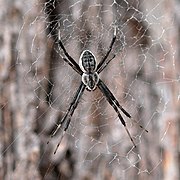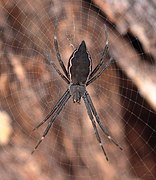
The genus Argiope includes rather large spiders that often have a strikingly coloured abdomen. These spiders are distributed throughout the world. Most countries in tropical or temperate climates host one or more species that are similar in appearance. The etymology of Argiope is from a Latin word argentum meaning silver. The carapace of Argiope species is typically covered in silvery hairs, and when crawling in the sun, they reflect it in a way that gives them a metallic, white appearance.
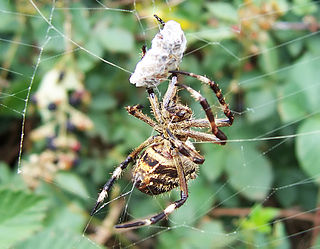
The Australian garden orb weaver spider is a very common species of spider with many variants in size, shape, and colour across the coastal and northern regions of Australia. They have very large abdomens when well-fed and exhibit a tremendous colour-range from off-white through tan, brown to almost black. They have a roughly leaf-shaped pattern on the top of their abdomen with a complex outline that is darker than the surrounding area. There may also be several whitish spots or one or more stripes. The spiders' cephalothoraxes (heads) and proximal leg segments are usually darker, mostly reddish or reddish brown. They are able to change their colour with each moult to better match the background upon which they rest during the day.

Austracantha is a genus of spider with a single species, Austracantha minax, commonly known as the jewel spider or the Christmas spider. It is a member of the family Araneidae and is endemic to Australia. They are relatively small spiders, reaching a maximum total body length of only around 12 mm (0.47 in) for females, and 5 mm (0.20 in) for males. Their abdomen has six distinctive projections ("spines") that makes them easy to identify. They are predominantly a shiny black, with variable white, yellow, and orange patterns. Melanistic forms also occur during autumn. They are facultatively gregarious, and can be found in large aggregations of overlapping orb webs. They feed on small flying insects that get entangled in their webs. They are harmless to humans, though the webs can be a nuisance for bushwalkers. They are most abundant during the summer months.

Argiope keyserlingi is a species of orb-web spider found on the east coast of Australia, from Victoria to northern Queensland. It is very similar in appearance to a closely related north Queensland species, Argiope aetherea. A. keyserlingi is commonly found in large populations in suburban parks and gardens, particularly among the leaves of Lomandra longifolia. Like many species of orb-web spider, A. keyserlingi shows considerable sexual dimorphism, as the females are many times larger than the males. Mature females can be seen during the summer, and seeing multiple males on the web of one female is not uncommon.

Argiope aetherea is a common, large orb-web spider. Like other species of Argiope, it is commonly known as the St Andrew's Cross spider, due to the characteristic cross-shaped web decorations female spiders often include in their webs. A. aetherea is similar in appearance to A. keyserlingi, however female A. aetherea are generally larger than A. keyserlingi. Like most orb-web spiders, A. aetherea shows considerable sexual size dimorphism, with females being many times larger than males.

Argiope picta is a species of orb web spider found in tropical areas of Queensland, Australia and Papua New Guinea up to the Moluccas. This species is similar in size to the sympatric Argiope aetherea; females can be distinguished from those of A. aetherea via extensive differences in abdominal colouration and patterns. The males of these two species are almost indistinguishable.

Argiope mascordi is a species of orb-web spider found in Queensland, Australia. The females of this species are smaller and less colourful than many other spiders in the genus Argiope. Males are larger than many other Argiope. Web decorations in this species are interesting in that A. mascordi juveniles construct a cross and adults construct a disc. The reason for this apparent reversal in decorating behaviour remains unknown.

Argiope bruennichi is a species of orb-web spiders distributed throughout Central and Northern Europe, North Africa, parts of Asia, and the Azores archipelago. Like many other members of the genus Argiope, it has strikingly yellow and black markings on its abdomen.
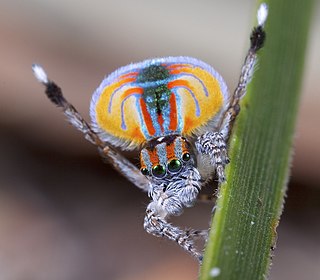
Maratus is a spider genus of the family Salticidae. These spiders are commonly referred to as peacock spiders due to the males' colorful and usually iridescent patterns on the upper surface of the abdomen often enhanced with lateral flaps or bristles, which they display during courtship. Females lack these bright colors, being cryptic in appearance. In at least one species, Maratus vespertilio, the expansion of the flaps also occurs during ritualised contests between males. The male display and courtship dance are complex, involving visual and vibratory signals.

Argiope protensa, commonly known as the tailed grass spider or teardrop spider, is a species of spider in the orb weaver family, Araneidae. This species is fairly common and widespread in Australasia, but like many spider species, little is known of its ecology, biology, or life history.
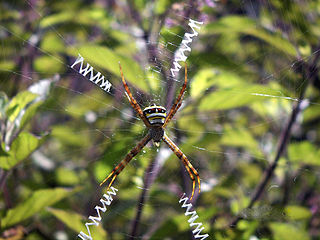
Argiope anasuja, is a species of harmless orb-weaver spider found from the Seychelles to India, Pakistan and Sri Lanka, in the Maldives and in the Brazil.

Argiope catenulata, also known as the grass cross spider, is a species of orb-weaver spiders ranging from India to the Philippines and Papua New Guinea, and also found in Australia in 2019. Like other species of the same genus, it builds a web with a zig-zag stabilimentum.
Nicodamus peregrinus, known as the red and black spider, is a spider found in eastern and southern Australia. Unlike the redback spider, the bright red colouration does not appear to warn of significant danger to humans. Food is a variety of small insects. They have been recorded in Queensland, New South Wales, Victoria and South Australia.

Argiope magnifica is a species of orb web spider found in tropical areas of north-east Queensland, Australia, eastern Papua New Guinea and the Solomon Islands. It is commonly known as the magnificent St Andrew's cross spider. This species is similar in size to the sympatric Argiope keyserlingi; females can be distinguished from those of A. keyserlingi via extensive differences in abdominal colouration and patterns. The males of these two species are almost indistinguishable.

Araneus praesignis is a species of orb-weaving spider found in Queensland, Australia where it is widespread and common in well-vegetated areas. The Atlas of Living Australia shows a record from New South Wales. It has bold black blobs on its rear, perhaps mimicking eyes. In 2014 Carly Brooke Martinetti gave it the common name "Alien Butt Spider" by which it became internationally known. Due to its memorable common name and strange appearance photographs of the spider have appeared in many online blogs and galleries. The purported 2015 sighting from China is of a different species of orb weaver because it has a different pattern of dark patches on the back and the photo does not show the actual alien eyes from which the common name is derived.

Artifex melanopyga, synonym Phonognatha melanopyga, referred to as a leaf curling spider, is a common Australian spider found in moist coastal areas of New South Wales and Queensland. A small member of the family Araneidae, the orb-weavers, it was previously placed in Tetragnathidae.

Argiope radon is a species of orb web spider native to Australia. It is found in tropical areas of the Northern Territory, Western Australia and Queensland. It is commonly known as the Northern St Andrew's cross spider.

Argiope katherina is a species of orb-weaver spider found in the northern parts of the Northern Territory and Western Australia. It was first described by Levi in 1983 and was named for Katherine Gorge. Specimens had been found at the mouth of split rock crevices up to one hundred metres from the Katherine River in sparse Pandanus-dominated territory.

Argiope australis, the common garden orb web spider, is an orb-web spider.
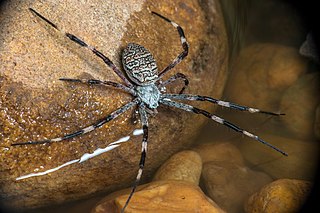
Argiope dietrichae is a rare species of orb-web spider found in the northern parts of Western Australia and the Northern Territory. It was first described by Levi in 1983, and it was named for Amalie Dietrich who collected specimens for the Godeffroy Museum in Hamburg.

